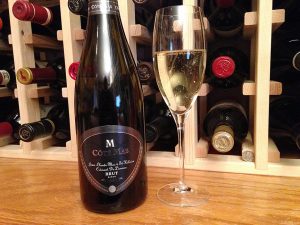Côté Mas Crémant de Limoux Brut St. Hilaire NV: Light yellow color; light honey nose; very persistent bubbles,
lemon, citrus on the palate, dry, crisp, good acidity; 60% chardonnay, 20% chenin blanc, 10% pinot noir, 10% mauzac. This is Languedoc wine, so it cannot be labeled Champagne, but it is made using same méthode traditionelle: grapes ferment in stainless steel to create base wine, a blend of sugar and yeast is added and the wine is bottled and sealed with a cap (similar to a beer or soda pop cap). A second fermentation occurs in the bottle, the bottle is turned upside down, and the lees (insoluble matter that settles from a liquid) fall to the top of the bottle. After a year of aging “sur pointe” (on the point), the bottles are chilled to freeze the lees, the bottle is opened, lees are removed and replaced with the “liqueur de dosage” (a mix of wine and sugar). The bottle is sealed with a traditional mushroom cork and aged for another year. That is a lot of work, which makes the price on this pour outstanding—you pay three or four times as much (at the least) when this is done in Champagne region. While Champagne may be snooty, St. Hilaire region has claim to being birthplace of sparkling. In 1531, Benedictine monks of the Abbey of Sainte Hilaire discovered the first effervescent wine in the world, then called “Blanquette de Limoux.” Dom Pérignon, the monk often associated with sparkling, worked in the late 1600s, and he spent most of his career trying to keep bubbles out of white wine. As often happens with wine, savor history while you sip. And, in this nice case, you can do it for or less than a Jackson. $17-19
